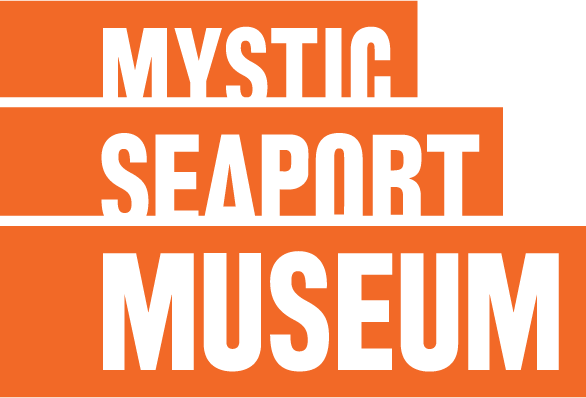
On Friday, April 29, Dana Hewson retired after working at Mystic Seaport for 39 years. He started here in 1977, as a Vessel Maintenance Supervisor, the first full-time ship keeper hired by Mystic Seaport. Hewson moved through the positions of Director of the Henry B. duPont Preservation Shipyard and Vice President of Watercraft Preservation and Facilities Management to his present position of Vice President of Watercraft Preservation and Programs. He was also the Museum’s first Clark Senior Curator for Watercraft. As the Clark Senior Curator, he provided direction and leadership in the preservation and development of the museum’s watercraft collection, which presently numbers more than 500 vessels of all sizes. In the course of his career, he led and helped develop the Museum’s maintenance and preservation program to its present status.
We asked Dana to take a walk with us during his last week at the Museum, stopping at the spots across the property that are most special to him. We were happy to have this opportunity to look back on a tremendous career with Dana, and to be able to thank him for all he has done for the Museum, the region, and maritime history and preservation.
The Shiplift
 “One thing that makes everything we do here possible is our shiplift,” Dana said. “After construction of Amistad, we knew the existing shiplift needed work, and it turned out to be more cost effective to replace it. This was a huge financial commitment to continuing the work we’ve always done here. And the goal with the replacement was to be environmentally compliant by every standard, and we did that.
“One thing that makes everything we do here possible is our shiplift,” Dana said. “After construction of Amistad, we knew the existing shiplift needed work, and it turned out to be more cost effective to replace it. This was a huge financial commitment to continuing the work we’ve always done here. And the goal with the replacement was to be environmentally compliant by every standard, and we did that.
“With the new shiplift, it means we can do two major vessel projects at once, and easily add a third smaller one. To be able to do all this efficiently and cleanly, well, without this capability everything would be very different. Starting in the 1970s, there were fewer and fewer places where we could get the work done that we needed to do – for our own ships and for others. The Shipyard is the largest curatorial arm of the Museum, and to be able to do all the work needed in one place is critical. This is a tremendous resource. We’ve built the Amistad, hauled the Lettie G. Howard, Draken Harald Hårfagre and now are restoring Mayflower II. Plus the Morgan and now Sabino.”
The Sawmill
 “Right now we have three sawmills on the property that allow us to create the shapes we need, using the species (of tree) we need. Modern sawmills don’t think the way we do, and they don’t work the way we need to work. So being able to do this ourselves, the way we need to, is important. And we are keeping skills alive. We’ve got a lot of people who come to work here to develop and hone their skills, and then they take them somewhere else. Of course, many stay. Right now we have one second generation Mystic Seaport shipwright. We don’t have an apprentice program, but we have taught a lot of people over the years.”
“Right now we have three sawmills on the property that allow us to create the shapes we need, using the species (of tree) we need. Modern sawmills don’t think the way we do, and they don’t work the way we need to work. So being able to do this ourselves, the way we need to, is important. And we are keeping skills alive. We’ve got a lot of people who come to work here to develop and hone their skills, and then they take them somewhere else. Of course, many stay. Right now we have one second generation Mystic Seaport shipwright. We don’t have an apprentice program, but we have taught a lot of people over the years.”
Stonington High School Crew
 In 1997, Mystic Seaport was approached by a group that wanted to start a rowing team at Stonington High School. They had everything set to create a team – except a place to call home. Other marinas along the Mystic River had turned down requests to host the team, but Dana told them they could use Mystic Seaport’s docks and storage facilities.
In 1997, Mystic Seaport was approached by a group that wanted to start a rowing team at Stonington High School. They had everything set to create a team – except a place to call home. Other marinas along the Mystic River had turned down requests to host the team, but Dana told them they could use Mystic Seaport’s docks and storage facilities.
“This is really special to me,” Dana says, stopping at the area where the crew team was prepping their equipment for the day’s practice. “We were able to accommodate them – they had everything all set, they just needed a place. I thought it was a terrific town-gown program to have and support, and I immediately said yes. My daughter Emma rowed for Stonington her four years of high school and rowed on scholarship for four years at the University of New Hampshire, and then helped pay for grad school by coaching. A large number of Stonington rowers get scholarships. It’s been wonderful. And now it has come full circle, because they are planning to build their own facility next door.”
Roann & Brilliant
 Asking Dana Hewson which is his favorite vessel at Mystic Seaport is akin to asking a mother to name her favorite child. But when pressed he will admit that it’s a tie between Roann and Brilliant, two very different boats. Roann is an Eastern-rig dragger, launched in 1947. Brilliant is a schooner designed by renowned naval architect Olin Stephens that just celebrated her 85th birthday and is used as a sail training vessel for teens and adults.
Asking Dana Hewson which is his favorite vessel at Mystic Seaport is akin to asking a mother to name her favorite child. But when pressed he will admit that it’s a tie between Roann and Brilliant, two very different boats. Roann is an Eastern-rig dragger, launched in 1947. Brilliant is a schooner designed by renowned naval architect Olin Stephens that just celebrated her 85th birthday and is used as a sail training vessel for teens and adults.
“I was involved in the acquisition of Roann, and one of these days she will be the last of her kind that is still afloat. And it’s because she’s been here and she’s been restored. She and Brilliant are form following function. They were each designed for a purpose and they are still operational. They are teaching vessels. They are still doing what they were meant to do. Brilliant has sailed with more than 10,000 teenagers on board. We have four National Historic Landmark vessels at Mystic Seaport, the highest designation of historical importance in this country. All were restored during my career.”
And it’s because she’s been here and she’s been restored. She and Brilliant are form following function. They were each designed for a purpose and they are still operational. They are teaching vessels. They are still doing what they were meant to do. Brilliant has sailed with more than 10,000 teenagers on board. We have four National Historic Landmark vessels at Mystic Seaport, the highest designation of historical importance in this country. All were restored during my career.”
Charles W. Morgan
The Charles W. Morgan whaleship underwent a five-year restoration in the Museum’s Henry B. duPont Preservation Shipyard from 2008 to 2013. She was launched July 21, 2013 in front of thousands of visitors at the Museum’s Shipyard and the celebration marked the kickoff to her return to sea. In late May, 2014, the Morgan departed her berth at Mystic Seaport and embarked on an unprecedented voyage to historic ports on the New England coast.
 “Certainly the Morgan was the most important (part of his career) to the Museum. Her influence on me and my influence on her were equal, I think. For her, it was her second major restoration, and for me, to be around that and to be responsible for maintaining her. And of course the voyage was a pinch-your-cheek moment. That was a significant moment for me personally and for the Museum.
“Certainly the Morgan was the most important (part of his career) to the Museum. Her influence on me and my influence on her were equal, I think. For her, it was her second major restoration, and for me, to be around that and to be responsible for maintaining her. And of course the voyage was a pinch-your-cheek moment. That was a significant moment for me personally and for the Museum.
“I was on her the first day she sailed away from New London, the first time she was under sail, and that was an amazing moment. All that work, the planning, the meetings, the logistics, and then to sail right off that dock. That was spectacular. It was as if it all came together, it all came to life, right then. For her to go from a moored to a sailing vessel, that was wonderful.”
Draken and Mayflower II
 “The technology of the Draken Harald Hårfagre (dates to) 1100. The technology of Mayflower II is 1620. The technology of the Morgan is 1840. The Joseph Conrad is 1880. The Sabino is 1908. To be able to have our visitors be able to view that progression in the technology of sail, and of ships, is amazing. We are able to show them that.”
“The technology of the Draken Harald Hårfagre (dates to) 1100. The technology of Mayflower II is 1620. The technology of the Morgan is 1840. The Joseph Conrad is 1880. The Sabino is 1908. To be able to have our visitors be able to view that progression in the technology of sail, and of ships, is amazing. We are able to show them that.”
The Bulkheads
 It certainly isn’t glamorous but it is really important: a multiyear project to replace 2,000 linear feet of bulkhead along the Mystic River in the 1980s. The project involved 9,000 tons of cut stone, 13,000 tons of rock fill, and cost $1.6 million. It was such an extensive and complex project that it actually has three plaques in its honor attached to the rear of the Stillman Building, facing the river. One of the plaques pays tribute to the late Waldo Howland, a trustee at the time who championed the need for the work to be done. “He was one of the most important mentors to me. It was Waldo who coined the phrase ‘The Mystic Way’ and that meant if you needed something done, you needed to do it yourself, because you would do it better and cheaper than anyone else.”
It certainly isn’t glamorous but it is really important: a multiyear project to replace 2,000 linear feet of bulkhead along the Mystic River in the 1980s. The project involved 9,000 tons of cut stone, 13,000 tons of rock fill, and cost $1.6 million. It was such an extensive and complex project that it actually has three plaques in its honor attached to the rear of the Stillman Building, facing the river. One of the plaques pays tribute to the late Waldo Howland, a trustee at the time who championed the need for the work to be done. “He was one of the most important mentors to me. It was Waldo who coined the phrase ‘The Mystic Way’ and that meant if you needed something done, you needed to do it yourself, because you would do it better and cheaper than anyone else.”

